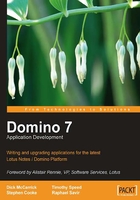
Domino Server
The Domino 7 server enhancements include autonomic diagnostic collection, a feature that can be considered both an administration feature as well as a server feature. This powerful feature is used to analyze various processes and events that are generated from a Notes client or Domino server after a crash. Autonomic diagnostic collection was first released with Notes and Domino 6.0.1. Be sure to take some time to understand and utilize this powerful tool.
Domino 7 includes more improvements to directories and LDAP; for example, support for Universal Notes IDs (UNID) through 32-character values of the new dominoUNID operational attribute. LDAP searches have been enhanced to work with IBM Workplace products that use the WebSphere Member Manager (WMM) service to access user/group objects. To optimize performance, Domino 7 re-uses existing LDAP connections, rather than initialize and close new ones for every user attempting to access protected resources whose credentials need to be verified in the external LDAP directory.
IPv6 protocol support has been upgraded to include additional platforms and services. CIDR format is now supported in IP address pattern strings. IOCP support in Linux Intel is included, as well as support for 1024-bit RSA and 128-bit RC2 Notes keys.
Administrators can limit how far into the future users can make reservations. Administrators can also set automatic reminder notices to be sent to the Chairperson who books a particular room/resource so that if a meeting is cancelled, the room/resource can be released. In addition, embedded graphics in the Description field now appear when you send an invitation through iCalendar.
Domino 7 has centralized the processing of Rooms and Resources reservations into a new Rooms and Resources Manager (RNRMgr) task. This task is designed to prevent overbooking of rooms or resources, and is responsible for both the processing and the workflow that is related to reserving Rooms or a Resource, as well as accurately updating the Busytime database. (Note that this task replaces functionality that was previously handled in multiple places such as the router, the template of the Rooms and Resources database, and the Schedule Manager.) You can rename a Resource by changing its name, Site, and (if the resource is of type "Other") its category.
Domino 7 also offers improvements with the Lightweight Third Party Authentication (LTPA) scheme. Domino 7 provides the ability for an administrator to configure the name that should appear in a LTPA token when a Domino server generates it. Setting up an alternate LTPA user name does not require a pure Domino environment.